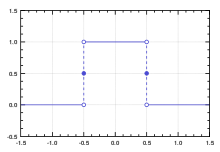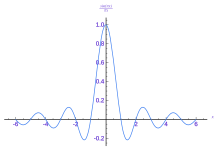Ideal low pass
An ideal low pass , also known as a si filter , sometimes called a Küpfmüller low pass (KTP) and usually referred to as a sinc filter , is a low pass in signal processing with the following ideal transfer function: Below a certain cut-off frequency with bandwidth B , all are Frequency components let through the filter, above the cutoff frequency B all frequency components are blocked. The ideal low-pass filter plays an important role as a model in filter theory, for example in the Nyquist-Shannon sampling theorem .
An ideal low-pass filter is easy to describe in theory, but cannot be implemented in practice. This is due to the non-causal and infinitely long impulse response. An ideal low-pass filter already shows a reaction at the filter output before the triggering signal is present at the filter input. Real low-pass filters therefore only approximate the transfer function of the ideal low-pass, but never achieve it, since otherwise they would have an infinite group delay.
Transfer function
Mathematically, the transfer function of the ideal low-pass filter in the time-continuous case with the rectangular function and the bandwidth B and the parameter of the frequency f can be described as:
In the time domain , the inverse Fourier transform of the transfer function results in the impulse response h (t):
The function si occurring here is also referred to as the si function or sinc function, from which the term sinc filter is derived for continuous-time filters .
In the time-discrete case, for example in digital signal processing , there are no continuous curves over time or the spectrum, but rather discrete sequences. The rectangular function shown above is replaced by a finite rectangular sequence with N spectral points. The inverse Fourier transform is replaced by the inverse discrete Fourier transform (IDFT). Because of the periodic continuation in the time domain in the discrete-time impulse response h (x) there is no si function, but a Dirichlet kernel . This is also referred to as the di function based on the si function and is defined as follows:
Occasionally, in the mostly English-language specialist literature, ideal low-pass filters are also referred to as sinc filters in the discrete-time case .
Individual evidence
- ^ Nocker, Rudolf: Digital communication systems. 1. Basics of baseband transmission technology . Vieweg, 2004, ISBN 978-3-528-03976-9 .
- ↑ Hoffmann, Rüdiger: Signal analysis and detection: An introduction for information technicians . Springer, 1998, ISBN 978-3-540-63443-0 .
literature
- Karl-Dirk Kammeyer: message transmission . 2nd Edition. Teubner, 1996, ISBN 3-519-16142-7 .




